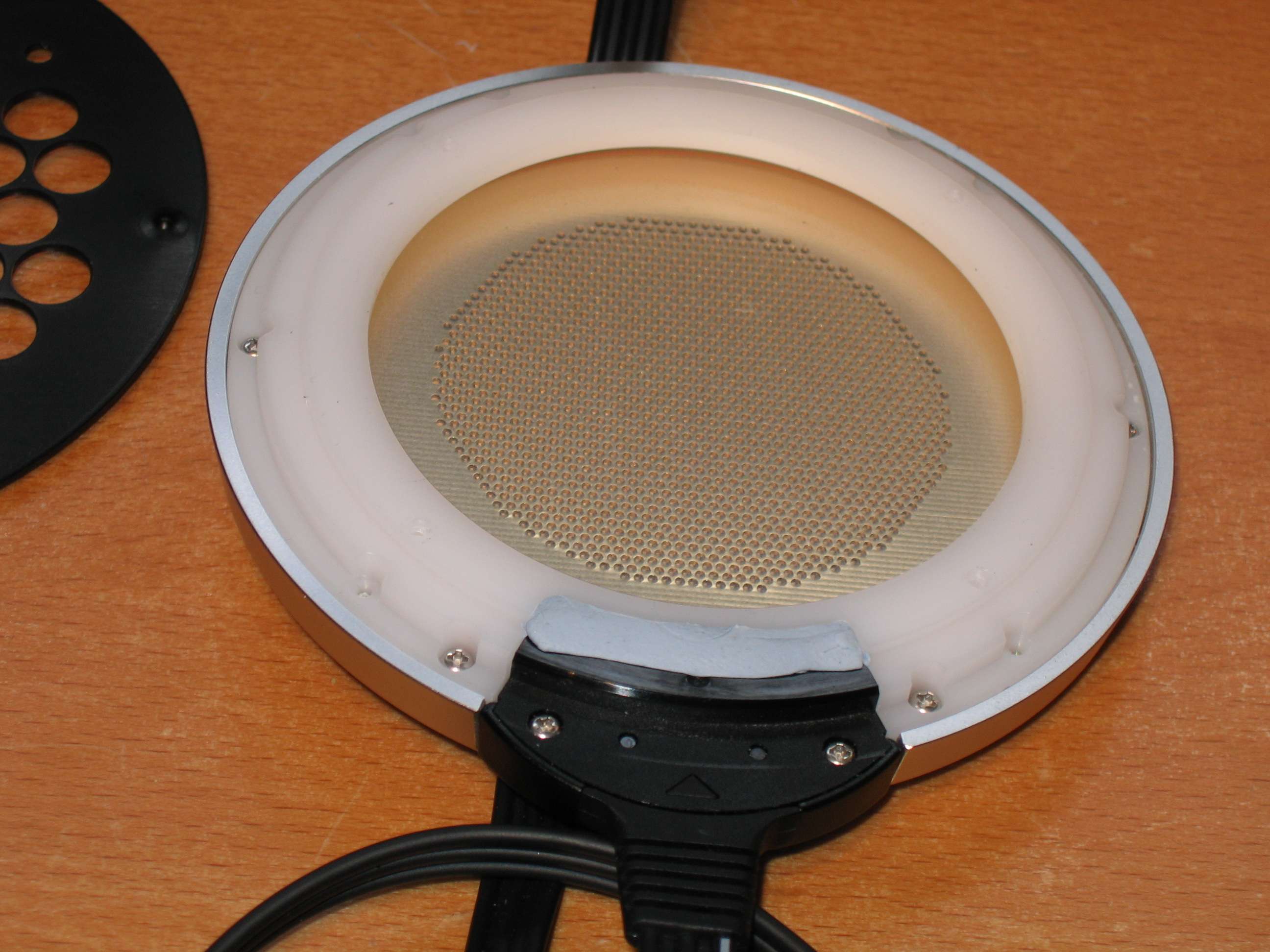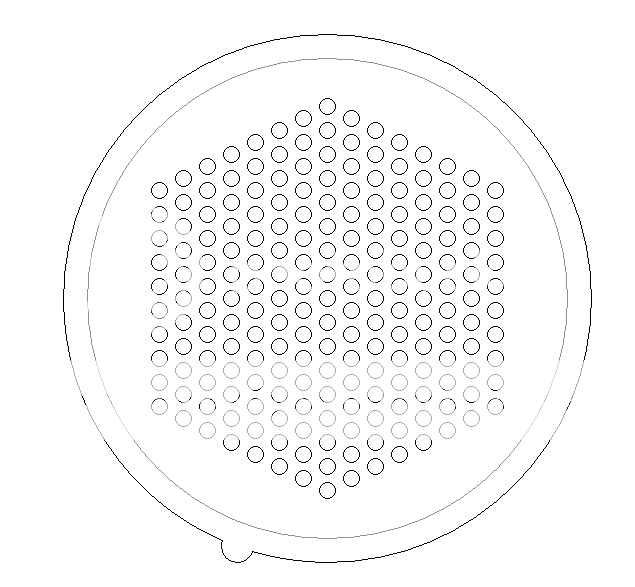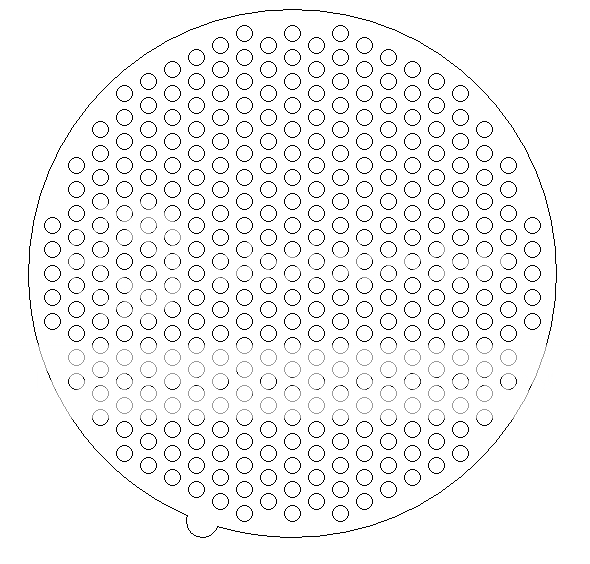Hi,
I have run into a gentleman at Head-Fi.org, and we discussed about the stators of electrostatic headphone. He showed me a picture taken from his Stax Sr-007 MK2 headphone. Obviously, the perforation on the stator are only concentrated in the middle of the stator leaving a big outer part of the stator without any holes.

I've drawn a similar design of the stator as shown in the picture below. The inner circle is where the spacer will be placed. What do you think is the advantage of this design?

Wachara C.
I have run into a gentleman at Head-Fi.org, and we discussed about the stators of electrostatic headphone. He showed me a picture taken from his Stax Sr-007 MK2 headphone. Obviously, the perforation on the stator are only concentrated in the middle of the stator leaving a big outer part of the stator without any holes.

I've drawn a similar design of the stator as shown in the picture below. The inner circle is where the spacer will be placed. What do you think is the advantage of this design?

Wachara C.
Hi,
my first guess was....."might there be some damping material between the spacer´s inner rim and the punched hole area?"
jauu
Calvin
ps. Wachara I now entitle You to kick my *** the first time we meet...because I still haven´t found time to build the HP with Your stators. *lool*
my first guess was....."might there be some damping material between the spacer´s inner rim and the punched hole area?"
jauu
Calvin
ps. Wachara I now entitle You to kick my *** the first time we meet...because I still haven´t found time to build the HP with Your stators. *lool*
Hi Calvin,
Thanks for your reply. I don't think that there is a damping material between the spacer's inner rim and the punched hole area. According to the guy at head-fi.com, his observation is that the area where there is no holes would damp some sound. What do you think? I'm tempting to cut out a pair of this design to see if I can hear any significant difference. Do you think that it will be worthwhile?
Wachara C.
Ps. By the way, no time is not a good excuse.

Thanks for your reply. I don't think that there is a damping material between the spacer's inner rim and the punched hole area. According to the guy at head-fi.com, his observation is that the area where there is no holes would damp some sound. What do you think? I'm tempting to cut out a pair of this design to see if I can hear any significant difference. Do you think that it will be worthwhile?
Wachara C.
Ps. By the way, no time is not a good excuse.


Leaving an area of diaphragm that is not driven around the outer edge of the speaker is exactly what Jim Strickland of Acoustat did. This will lower the diaphragms resonant frequency as well as provide some extra material from which the driven area can borrow to stretch when driven. That should help to keep the diaphragm motion pistonic. There will also be some loss and damping in the non driven section which is good.
If you really want to find out the difference you will have to build two sets of stators using the same diaphragm tension in both and the same area of diaphragm with the difference being that one set leaves an outer gap of non driven diaphragm. I would expect the ones with the non driven gap to sound a little better.
If you really want to find out the difference you will have to build two sets of stators using the same diaphragm tension in both and the same area of diaphragm with the difference being that one set leaves an outer gap of non driven diaphragm. I would expect the ones with the non driven gap to sound a little better.
Hi,
I´m a bit puzzled about the claim of lower resonace frequency. I think this wouldn´t be true comparing same (free vibrating) membrane areas which differ in coated area.
It would be true if the ´passive´ membrane area would be added as a kind of a large surround to the coated area, but this means different membrane sizes.
I don´t expect much damping from just a small ´non driven´ rim, but if a bit of dampfing material would touch the membrane, this could introduce effective damping of standing waves which devolp through the reflection of waves running over the mebrane´s surface towards the stator-rims. In this case small rings of soft foam or wool at the inside of the spacer-rings might be effective.
jauu
Calvin
ps: Wachara...dear old friend....if I had a good excuse...do You really think I´d allow You to kick my ***???? *lol*
I´m a bit puzzled about the claim of lower resonace frequency. I think this wouldn´t be true comparing same (free vibrating) membrane areas which differ in coated area.
It would be true if the ´passive´ membrane area would be added as a kind of a large surround to the coated area, but this means different membrane sizes.
I don´t expect much damping from just a small ´non driven´ rim, but if a bit of dampfing material would touch the membrane, this could introduce effective damping of standing waves which devolp through the reflection of waves running over the mebrane´s surface towards the stator-rims. In this case small rings of soft foam or wool at the inside of the spacer-rings might be effective.
jauu
Calvin
ps: Wachara...dear old friend....if I had a good excuse...do You really think I´d allow You to kick my ***???? *lol*
Leaving an area of diaphragm that is not driven around the outer edge of the speaker is exactly what Jim Strickland of Acoustat did. This will lower the diaphragms resonant frequency as well as provide some extra material from which the driven area can borrow to stretch when driven. That should help to keep the diaphragm motion pistonic. There will also be some loss and damping in the non driven section which is good.
This is what I originally thought when I saw the pics chinsettawong posted. But, if you look carefully, the stator is conductive all the way to the edge. It is just the perforation hole pattern that does not extend to the edge. So, the diaphragm is driven edge to edge, but the available exit area for the sound is somewhat smaller.
I have seen a similar technique used for planar ribbon tweeters to improve dispersion yet still retain the low Fs of a larger diaphragm. But, this is for heaphone use, so I'm not sure what to make of it.
if the diaphragm is coated all the way out to the stator clamps then the solid area of stator would provide a lot of damping to the diaphragm via the solid outer driven section of the diaphragm by way of air compression.
With a mechanical drive system one can use physical damping in contact with the diaphragm but not in an ESL. Even with mechanical designs small fibers can buzz and rattle like you would not believe so you have to be very careful with any damping that makes contact with the diaphragm. Resistive air traps which are progressive (large gap to small gap) are very effective. Back in the day we got this aspect of our design included in our US patent of a planar magnetic design.
With a mechanical drive system one can use physical damping in contact with the diaphragm but not in an ESL. Even with mechanical designs small fibers can buzz and rattle like you would not believe so you have to be very careful with any damping that makes contact with the diaphragm. Resistive air traps which are progressive (large gap to small gap) are very effective. Back in the day we got this aspect of our design included in our US patent of a planar magnetic design.
- Status
- This old topic is closed. If you want to reopen this topic, contact a moderator using the "Report Post" button.
- Home
- Loudspeakers
- Planars & Exotics
- ESL Open Area Question
